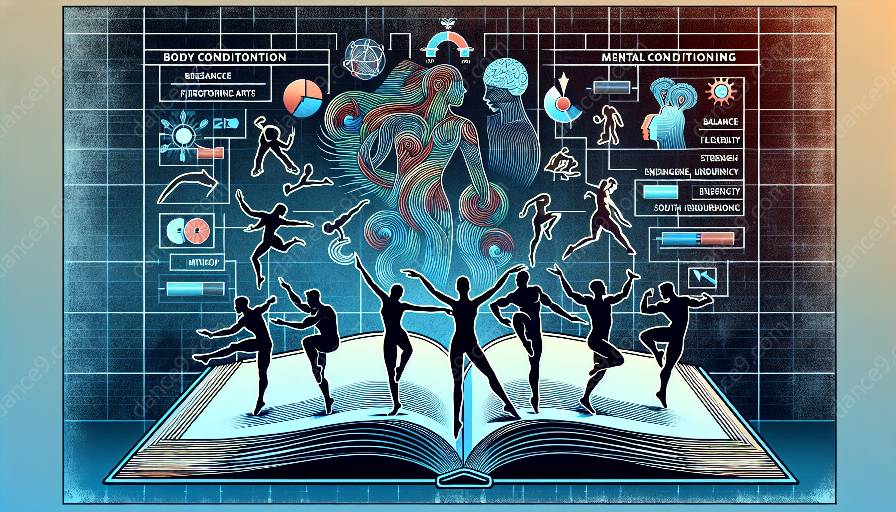Flexibility and strength training are essential components of body conditioning for dancers. In the rigorous world of dance, maintaining a balance between flexibility and strength is crucial for optimal performance and overall well-being. This topic cluster explores the significance of flexibility and strength training in dance conditioning and their profound impact on the physical and mental health of dancers.
The Importance of Flexibility in Dance Conditioning
Flexibility plays a vital role in the art of dance. It enables dancers to achieve a wide range of motion, perform challenging movements, and express themselves creatively through fluid movements. Effective flexibility training helps dancers enhance their agility, extension, and overall joint mobility, allowing them to execute intricate choreography with grace and precision.
- Improved Range of Motion: Flexibility training aids in expanding the range of motion in joints, which is crucial for executing various dance movements with ease and fluidity.
- Injury Prevention: Adequate flexibility reduces the risk of muscle strains, ligament sprains, and other dance-related injuries by promoting proper body alignment and balanced muscle development.
- Enhanced Performance: Increased flexibility contributes to the refinement of dance techniques, enabling dancers to achieve seamless transitions and execute complex movements more effectively.
The Role of Strength Training in Dance Conditioning
Strength training forms the foundation of a dancer's physical readiness and endurance. While flexibility allows for expressive movement, strength provides the necessary support and stability for executing various dance techniques. Incorporating strength training into dance conditioning programs is essential for building a resilient and well-supported body.
- Muscular Endurance: Strength training improves muscular endurance, enabling dancers to sustain demanding movements and routines without fatiguing easily.
- Core Stability: A strong core is essential for maintaining balance, posture, and stability during intricate dance sequences. Core-focused strength training helps dancers develop the necessary foundation for executing challenging movements.
- Injury Resilience: Building strength in supporting muscles and stabilizers reduces the risk of overuse injuries and provides additional support for the body during physically demanding performances.
Integrated Approach: Flexibility and Strength Training
An integrated approach to dance conditioning involves balancing flexibility and strength training to optimize performance and mitigate the risk of injuries. By combining targeted flexibility exercises with strength-building routines, dancers can achieve a harmonious balance between mobility, stability, and strength.
Integrated dance conditioning programs often incorporate various training modalities, including:
- Dynamic Stretching: Dynamic stretching exercises help improve flexibility while engaging the muscles to enhance overall mobility and prepare the body for dance-specific movements.
- Resistance Training: Resistance training, such as bodyweight exercises, Pilates, and functional strength training, aids in developing muscular strength and endurance, crucial for sustained performance and injury prevention.
- Balance and Stability Exercises: Balance and stability training activities contribute to enhancing proprioception and neuromuscular control, promoting better alignment and reducing the risk of falls and injuries.
Body Conditioning for Dancers: Optimizing Performance and Health
Body conditioning for dancers encompasses a holistic approach to physical preparation, encompassing flexibility and strength training as integral pillars of the conditioning process. By prioritizing the development of both flexibility and strength, dancers can achieve peak performance while safeguarding their physical well-being.
Key elements of body conditioning for dancers include:
- Breath Awareness: Incorporating breath work into conditioning routines enhances lung capacity, promotes relaxation, and fosters mind-body connection essential for expressive dance performances.
- Recovery Practices: Emphasizing restorative practices, such as foam rolling, stretching, and adequate rest periods, supports the body's recovery and reduces the likelihood of overuse injuries.
- Nutritional Support: A well-balanced diet tailored to the nutritional needs of dancers is vital for sustaining energy levels, promoting muscle recovery, and supporting overall physical health.
Physical and Mental Health in Dance: The Holistic Impact
Physical and mental health are intertwined aspects of a dancer's well-being, and an integrated approach to flexibility and strength training plays a pivotal role in supporting both dimensions.
The holistic impact of comprehensive dance conditioning on physical and mental health includes:
- Injury Prevention: By addressing flexibility and strength in dance conditioning, dancers are better equipped to prevent common dance-related injuries, supporting their physical well-being and longevity in the art form.
- Stress Reduction: Engaging in targeted flexibility and strength training not only enhances physical performance but also serves as a means of stress relief, promoting mental rejuvenation and overall well-being.
- Confidence Building: A balanced approach to flexibility and strength training empowers dancers to feel more confident in their physical capabilities, fostering a positive mindset and enhancing mental resilience.
Conclusion
Flexibility and strength training are foundational elements of dance conditioning, essential for enabling dancers to achieve peak performance while safeguarding their physical and mental well-being. By embracing an integrated approach that balances flexibility, strength, and holistic body conditioning, dancers can optimize their physical capabilities, reduce the risk of injuries, and promote a sustainable and fulfilling dance practice.


































